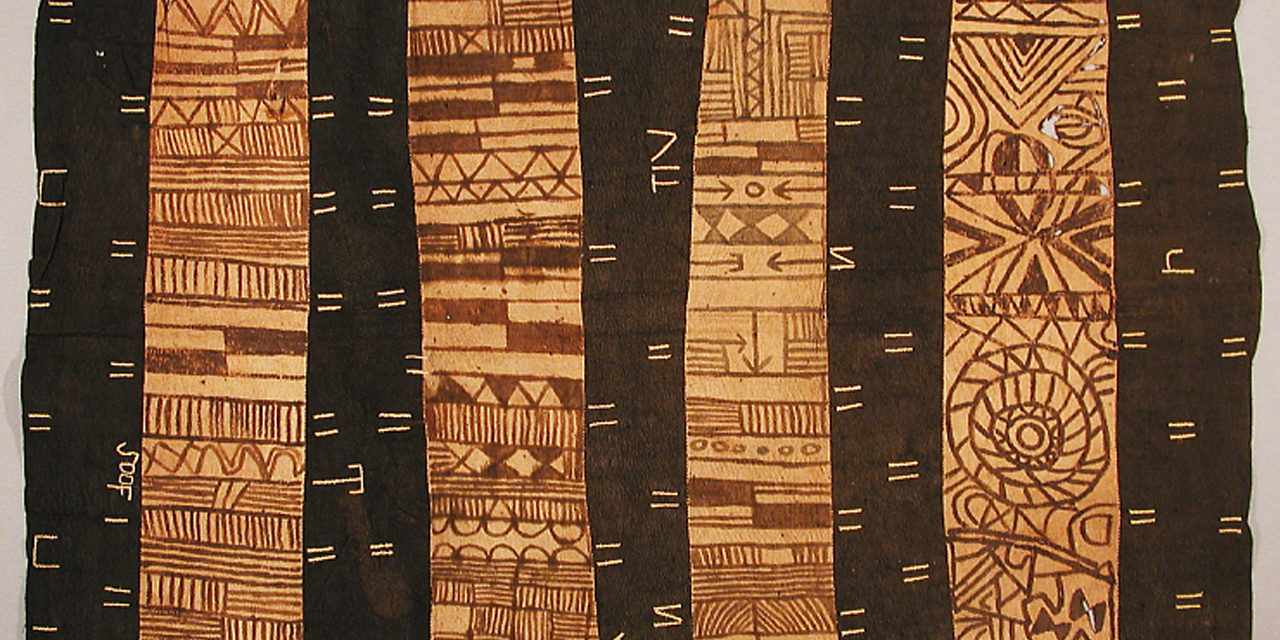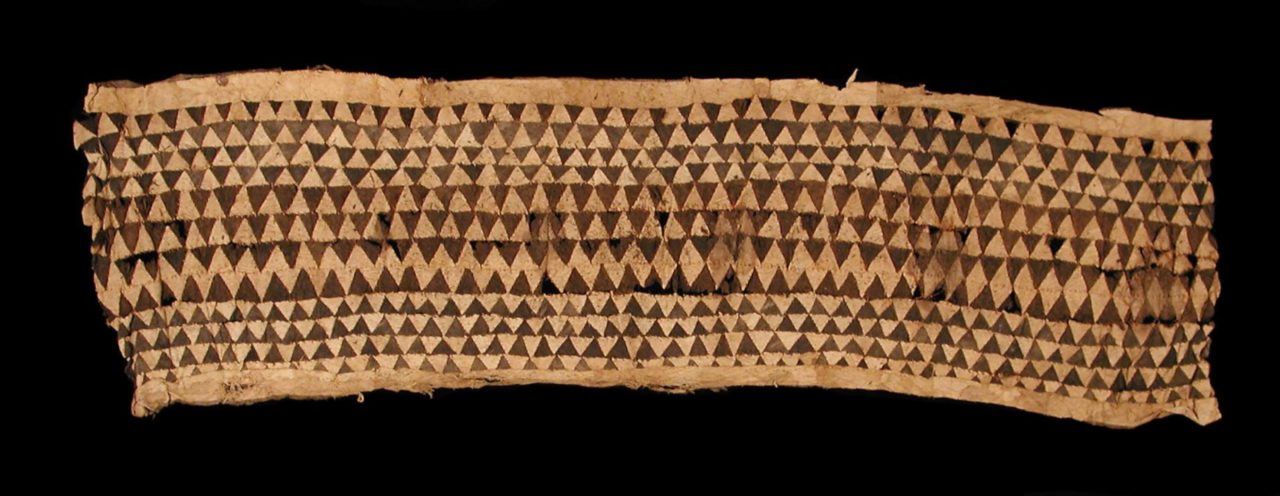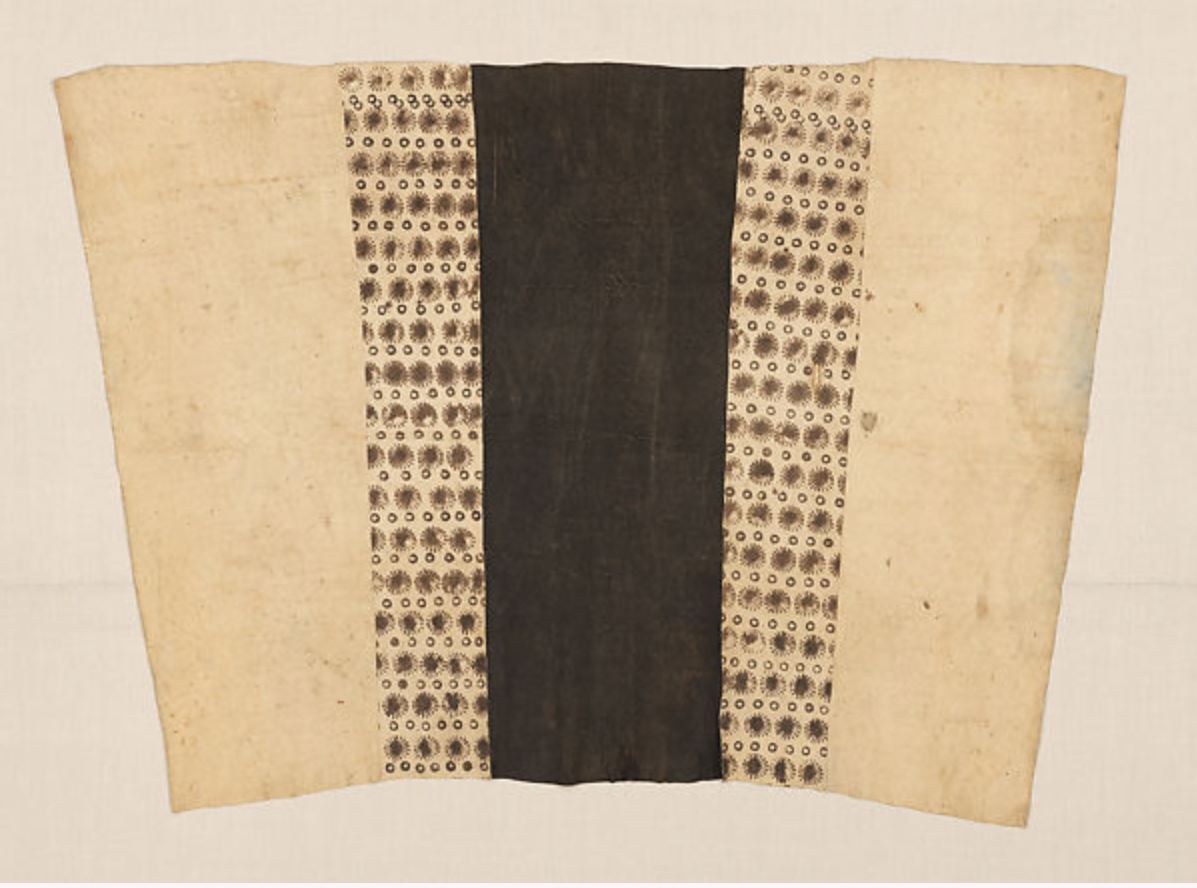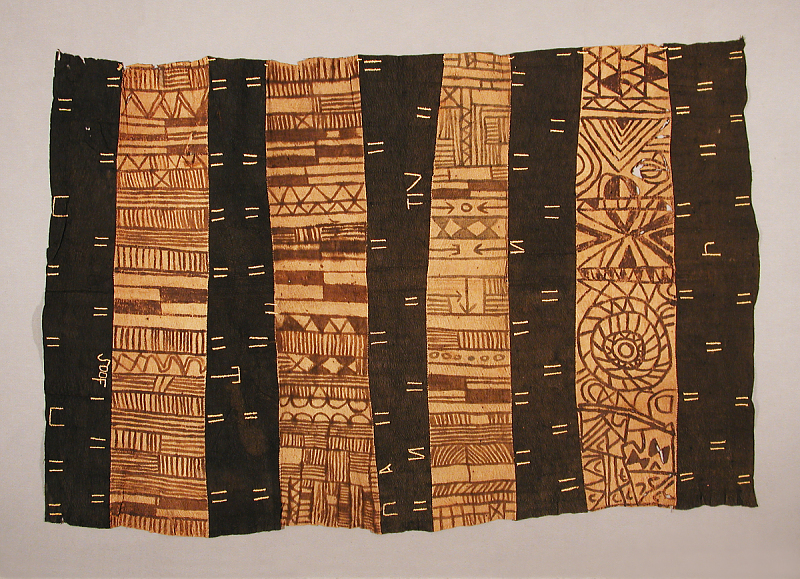Bark cloth is fabric made out of bark from trees.
The Details
In the Berg Encyclopedia of World Dress and Fashion: Africa (2010), Sandra Klopper and Rehema Nchimbi describe the history and production of bark cloth in Africa:
“In East and Central Africa, bark cloth made by stripping, scraping, and beating the inner bark of certain trees, most commonly the Ficus species, was widely used long before Arab traders introduced weaving to the region. Historically, this cloth was employed for a variety of mundane purposes; but among the Baganda of Uganda, where it is still used in healing ceremonies as shrouds and during the investiture of the heir to the throne, it attained spiritual significance. Although the production of this cloth was once very widespread, it declined rapidly in the course of the nineteenth century, when imported cloth began to dominate the East African market.”
Figure 1 is a close-up view of barkcloth; it highlights the texture of the barkcloth which helps to understand the process of how it is made. Figure 2 is an overskirt made of barkcloth by the Kuba peoples.
In an article on African fashion from prehistory to colonialism in the Berg Encyclopedia of World Dress And Fashion, Marie-Amy Mbow explains that bark cloth was one of the dominant forms of dress in parts of Africa:
“For the numerous regions south and southwest of Ethiopia and Mozambique, textiles for clothing were nearly unknown. Most men wore only a piece of bark cloth, animal hides, or leather around their shoulders and hips.”
In the an article describing Zande bark cloth, Amy Oakland describes the close linguistic link between bark cloth and clothing:
“One term for bark cloth in Zande is bagadi, derived from the Mangbetu word nebagadi—which underlines the historical link. The other term is roko, which means both ‘bark cloth’ and ‘cloth’ in general and is also the name of the cultivated fig trees from which bark cloth is made. That the name of a bark cloth tree is synonymous with the word for ‘cloth’ or ‘clothing’ is not uncommon in this part of the world. Besides the roko tree (Ficus platyphylla or Ficus natalensis), the Zande of the Central African Republic exploit two other trees: ndasu (probably Ficus capensis) and wangaru (unidentified). The first tree produces soft, light brown bark cloth, the second reddish bark cloth, and the third stiff white bark cloth.”
Figure 3 is an example of ficus roko bark cloth that was worn draped around the body as pants by chiefs of the Mangbetu people. Figure 4 is a piece of painted bark cloth from the Democratic Republic of Congo where you can see the light brown coloring of barkcloth.
Fig. 1 - Asante (Ghana). Barkcloth, 1850-1927. Barkcloth; 86 x 63 cm. British Museum, Af1978,22.62. Source: British Museum
Fig. 2 - Kuba Artist (Democratic Republic of the Congo, Mid-20th century). Overskirt Panel, Mid-20th century. Barkcloth, raffia; 163.8 x 47 cm (64.5 x 18.5 in). Smithsonian National Museum of African Art, 67-30-1. Museum Purchase. Source: Smithsonian National Museum of African Art
Fig. 3 - Maker unknown (Democratic Republic of the Congo). Chief's Wrapper (nogi), first half of 20th century. Bark of "ficus roko" or "urostigma kotschyana" joined with raffia stitching and stamped with natural dyes; 190 x 200 cm. 2012.334. Purchase, The Richman Family Foundation Gift, in honor of Alisa LaGamma, 2012. Source: The Met
Fig. 4 - Mbuti artist (Democratic Republic of the Congo). Display Cloth, 1955. Barkcloth, raffia, dye; 208.3 x 134.6 cm (82 x 53 in). Washington: Smithsonian National Museum of African Art, 77-44-1. Source: Smithsonian National Museum of African Art
References:
- Klopper, Sandra, and Rehema Nchimbi. “East Africa.” In Berg Encyclopedia of World Dress and Fashion: Africa, edited by Joanne B. Eicher and Doran H. Ross. Oxford: Berg Publishers, 2010. Accessed February 20, 2021. https://libproxy.fitsuny.edu:2648/products/berg-fashion-library/encyclopedia/berg-encyclopedia-of-world-dress-and-fashion-africa/east-africa
- Mbow, Marie-Amy. “Prehistory to Colonialism.” In Berg Encyclopedia of World Dress and Fashion: Africa, edited by Joanne B. Eicher and Doran H. Ross, 172–179. Oxford: Berg Publishers, 2010. Accessed February 12, 2021. https://libproxy.fitsuny.edu:2648/products/berg-fashion-library/encyclopedia/berg-encyclopedia-of-world-dress-and-fashion-africa/prehistory-to-colonialism
- Oakland, Amy. “Zande Bark Cloth.” In Berg Encyclopedia of World Dress and Fashion: Africa, edited by Joanne B. Eicher and Doran H. Ross. Oxford: Berg Publishers, 2010. Accessed February 1, 2021. https://libproxy.fitsuny.edu:2648/products/berg-fashion-library/encyclopedia/berg-encyclopedia-of-world-dress-and-fashion-africa/zande-bark-cloth














